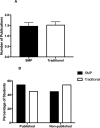Premedical special master's programs increase USMLE STEP1 scores and improve residency placements
- PMID: 29190691
- PMCID: PMC5708752
- DOI: 10.1371/journal.pone.0188036
Premedical special master's programs increase USMLE STEP1 scores and improve residency placements
Abstract
The effectiveness of Special Master's Programs (SMPs) in benefiting a potential medical student's career beyond admission into an MD-program is largely unknown. This study aims to evaluate the role of SMPs, if any, in affecting the performance and outcomes of students during their medical school career. This study analyzed anonymous surveys of students and residents from the University of Toledo. The data analysis is used to evaluate a student's academic performance before, during and after medical school. Measured metrics included: MCAT Scores, undergraduate GPA, USMLE STEP 1 scores, participation in research, number of research publications, and residency placement. Of 500 people surveyed 164 medical students or residents responded. Based on their responses, the respondents were divided into traditional (non-SMP) and SMP groups. As anticipated, MCAT scores (SMP: 29.82 vs. traditional 31.10) are significantly (p<0.05) different between the two groups. Interestingly, there is no significant difference in USMLE STEP 1 scores (SMP: 232.7 vs. traditional: 233.8) and when normalized relative to MCAT scores, USMLE STEP 1 scores for SMP-students are significantly (p<0.05) higher than their traditional counterparts (p<0.05). Additionally, SMP-students did not outperform the traditional students with regards to research publications. But, they did demonstrate a significant (p<0.05) proclivity towards surgical residencies when compared to the traditional students. Overall, our results highlight that SMPs potentiate USMLE STEP 1 performance and competitive residency-placements for its students.
Conflict of interest statement
Figures





References
-
- Considering a Postbaccalaureate Premedical Program. AAMC Students, Applicants and Residents. 20 Sept 2015. Available from: https://students-residents.aamc.org/content/article/considering-postbacc....
-
- Simon, C. A Second Opinion: The Post-Baccalaureate. The New York Times. 15 Apr 2012 Available from: http://www.nytimes.com/2012/04/15/education/edlife/a-second-opinion-the-....
-
- Burnsed B. An Expensive, Alternative Route to Medical School. 25 Jul 2011 Available from: https://www.usnews.com/education/best-graduate-schools/articles/2011/07/....
-
- Epps AC. The Strategic Impact of a Post Baccalaureate Pre-medicine Intervention Program on Medical School Academic Performance. Journal of Health Care for the Poor and Underserved. 2015;26(1):8–20. doi: 10.1353/hpu.2015.0008 - DOI - PubMed
-
- McDougle L, Way D, Clinchot D. A National Long-term Outcomes Evaluation of U.S. Premedical Postbaccalaureate Programs Designed to Promote Health care Access and Workforce Diversity. Journal of Health Care for the Poor and Underserved. 2015;(3): 631 doi: 10.1353/hpu.2015.0088 - DOI - PMC - PubMed
MeSH terms
LinkOut - more resources
Full Text Sources
Other Literature Sources
Research Materials

